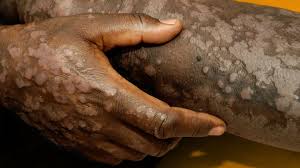
Understanding Your Skin: Post-Inflammatory Hyperpigmentation
September 23, 2024
Understanding Your Skin: Eczema (On Dark Skin)
October 7, 2024Despite the media representations of psoriasis often only showing how it affects people with lighter skin tones, it also affects people of all races, including Africans and other people of colour. Psoriasis may also cause a similar symptom of itchiness for everyone, but its symptoms often look different from person to person. So, what is psoriasis? And how can one treat or prevent it? We’ll be talking about all of that below. But first, let’s get familiar with this skin issue.
What Is Psoriasis?
Psoriasis is a common, chronic inflammatory skin disorder that affects more than 125 million worldwide. It is a long-term condition that a person may develop at any age, but there are two common onset peaks; ages 20–30 and 50–60. While there is no cure, many treatment options are available to help manage the symptoms.

What Does Psoriasis Look Like On Dark Skin?
On people with dark skin tones, psoriasis plaque can range from light to dark brown, purple or grey colours. Each type of psoriasis can look different based on the type and where it is on your body. Sometimes, the resultant skin discolouration isn’t visible on dark skin tones making it almost easy to miss.
Psoriasis may also leave evidence of a flare-up in darker skin tones while areas of thickened skin will disappear, discolouration from psoriasis plaques can remain on your skin for up to a year. Note that the discolouration isn’t permanent, and a dermatologist can offer treatment to speed up your body’s healing process.
Causes Of Psoriasis
The major cause of psoriasis is an over-reactive immune system that creates inflammation in your skin. Our immune system is supposed to destroy foreign invaders, like bacteria, to keep us healthy and prevent us from getting sick. Instead, people with psoriasis’s immune system can mistake healthy cells for foreign invaders. As a result, their immune system creates inflammation or swelling, which they see on the surface of their skin as skin plaques.
It usually takes up to 30 days for new skin cells to grow and replace old skin cells. But over-reactive immune system causes the timeline of new skin cell development to change to three to four days. The speed of new cells replacing old cells creates scales and frequent skin shedding on top of skin plaques.
Another cause of psoriasis is genetics; when it runs in families, biological parents pass the condition down to their children.
An outbreak or flare-up of psoriasis causes symptoms to increase due to contact with a trigger, which could be an irritant or an allergen. Psoriasis outbreaks differ from person to person. Common triggers for psoriasis flare-ups include emotional stress, an infection (streptococcal infection), a skin injury like cuts, scrapes or surgery, certain medications, such as lithium and beta-blockers, and changes in body temperature due to the weather.
Who Can Develop Psoriasis?
Anyone can develop psoriasis, but it most often begins between ages 15 and 35, or as people get older. Psoriasis isn’t contagious meaning that it doesn’t spread to other people.
Psoriasis may be worse in people who have a weak immune system, including people with HIV/AIDS. Some people with psoriasis also have arthritis (psoriatic arthritis). In addition, people with psoriasis have an increased risk of fatty liver disease and cardiovascular disorders, such as heart disease and stroke.

What Are The Symptoms Of Psoriasis?
Psoriasis often presents as thickened areas of skin, often with an overlying shiny and scaly crust. These affected areas of skin are usually itchy but if you scratch them, they will bleed and scab over. It can look violet or purple on dark skin and you may also notice areas of darker, thicker skin. These psoriasis lesions can develop anywhere on the body, including the scalp.
As psoriasis heals, it can leave areas of discolouration, which can take up to 3–12 months to disappear. People with psoriasis will experience cyclic periods of few or no symptoms and a flare-up of more severe symptoms. As mentioned above, there are different types of psoriasis, which can vary in their appearance, including:
- Plaque psoriasis – This is the most common form of psoriasis and it causes clearly defined lesions on the elbows, knees, and scalp.
- Erythrodermic psoriasis – This is a scaly skin rash (plaque) that covers a large area of your body. It often looks like a burn.
- Guttate psoriasis – This type is more common in children or young people recovering from an infection, such as strep throat. It causes small bumps that can cover the entire body.
- Nail psoriasis – Some people with psoriasis only have symptoms on their nails. Nail psoriasis looks like tiny pinpricks on the fingernails or toenails. It can look like nail pits, or small dents, discolouration, thickening or crumbling of the nail, nails separating from the skin beneath, or even blood under the nail.
- Inverse psoriasis – This type often appears on folds where the skin touches another part of the skin like the armpits, the buttocks, the groin, and the folds underneath the breasts. The lesions may be purple or darker than the surrounding skin.
How To Prevent Psoriasis
There is no proven way to prevent psoriasis. The solutions that are available aid the improvement of symptoms and reduction of the number of psoriasis flare-ups that one can have. Contact your dermatologist to prescribe a special topical product or medications for serious cases of psoriasis. For mild cases of psoriasis, you can apply the Kanda Body Balms on the affected areas as may times as necessary throughout the day to improve the dryness and itching.
How To Treat Psoriasis
There are several options available for treating psoriasis because individual treatments can react differently on different people. As a result, the best treatment option for you might not work as well for someone else. That said, the common treatment options for psoriasis include:
- Topical creams or ointments like the Kanda range of Body Balms.
- Medicated lotions or shampoos.
- Steroid creams.
- Medications or immune therapies.
- Light therapy.
If you have psoriasis, following your doctor’s advice as strictly as possible is most important. In addition to the treatments prescribed by your doctor, you can do a lot on your own to help control and prevent flare-ups like:
- Not picking at the patches or scales as you may make your psoriasis worse.
- Use a humidifier when the air inside your house is dry as your skin needs moisture.
- Avoid injuries like scrapes, cuts and bumps as these can cause trauma & Infections to your skin.
- Don’t stay too long in the sun as it can dry out your skin.
- Exercise, eat right, avoid stress and maintain a healthy weight.

